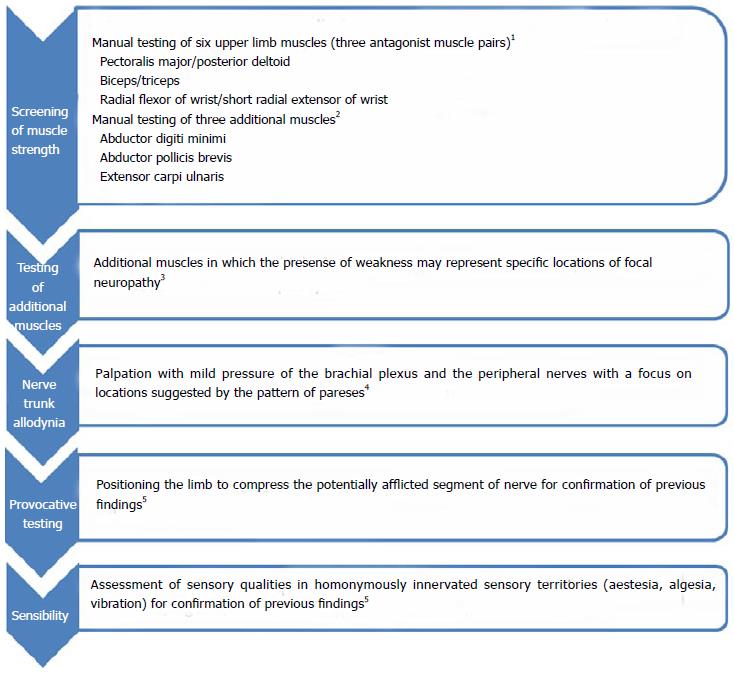Copyright
©The Author(s) 2015.
World J Methodol. Jun 26, 2015; 5(2): 26-30
Published online Jun 26, 2015. doi: 10.5662/wjm.v5.i2.26
Published online Jun 26, 2015. doi: 10.5662/wjm.v5.i2.26
Figure 1 An algorithm for an upper limb neurological examination in patients with work-related upper-limb complaints.
1Manual testing of six upper limb muscles is a sensitive measure, which can suggest the presence of the majority of upper limb nerve afflictions but confirmation of focal neuropathy requires the demonstration of mechanical nerve trunk allodynia at the location(s) that are suggested by the pattern of pareses[11]. The combination of manual muscle testing and nerve trunk palpation is able to increase the specificity of the neurological examination; 2Screening of strength in the six muscles applied for the initial screening cannot identify focal neuropathy at three common locations: Ulnar neuropathy will result in weakness in the abductor digiti minimi, carpal tunnel syndrome will be associated with paretic abductor pollicis brevis muscle, and radial tunnel syndrome causes weakness in the extensor carpi ulnaris muscle. Therefore manual testing of these three muscles is also recommended. If all nine muscles are of normal strength, a peripheral nerve affliction is unlikely. If weaknesses are found, additional muscles should be tested[12]; 3The muscles selected to be recommended for screening are those that according to the author are the more rewarding in the diagnosis of upper limb nerve afflictions. Depending on the clinical situation nerve afflictions of less frequency may be looked for by examining additional muscles[7]; 4The identification of mechanical allodynia at location(s) suggested by the pattern of pareses will improve the specificity of the examination and contribute to its validity[11]; 5Provocative testing and assessment of sensory qualities serve to reassure the examiner of the neurological findings. Examples of the former are the well-known Phalen sign with carpal tunnel syndrome and the hyperabduction test with an infraclavicular brachial plexus affliction. Passive compression of the posterior interosseous nerve by passive forearm hyperpronation will provoke the pain associated with a radial tunnel syndrome. While upper limb tension tests have been developed to indicate bias towards the median, radial, and ulnar nerves, respectively[13], they cannot, however, determine the level(s) of afflicted location(s) along these nerves. The same is the case for sensory assessment. Therefore manual muscle testing is the key to the neurological upper limb assessment.
- Citation: Jepsen JR. Clinical neurological examination vs electrophysiological studies: Reflections from experiences in occupational medicine. World J Methodol 2015; 5(2): 26-30
- URL: https://www.wjgnet.com/2222-0682/full/v5/i2/26.htm
- DOI: https://dx.doi.org/10.5662/wjm.v5.i2.26









